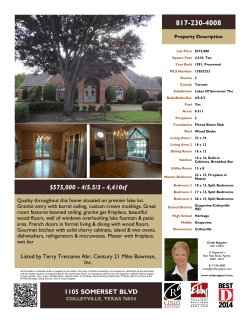
AD VIVUM? Friday 21 November and Saturday 22 November 2014
AD VIVUM? Friday 21 November and Saturday 22 November 2014 The Courtauld Institute of Art, Somerset House, Strand, London WC2R 0RN The term ad vivum and its cognates al vivo, au vif, nach dem Leben and naer het leven have been applied since the thirteenth century to depictions designated as from, to or after (the) life. This one and a half day event will explore the issues raised by this vocabulary in relation to visual materials produced and used in Europe before 1800, including portraiture, botanical, zoological, medical and topographical images, images of novel and newly discovered phenomena, and likenesses created through direct contact with the object being depicted, such as metal casts of animals. It is has long been recognised that the designation ad vivum was not restricted to depictions made directly after the living model, and that its function was often to advertise the claim of an image to be a faithful likeness or a bearer of reliable information. Viewed as an assertion of accuracy or truth, ad vivum raises a number of fundamental questions about early modern epistemology – questions about the value and prestige of visual and/or physical contiguity between image and original, about the kinds of information which were thought important and dependably transmissible in material form, and about the roles of the artist in this transmission. The recent interest of historians of early modern art in how value and meaning are produced and reproduced by visual materials which do not conform to the definition of art The Courtauld Institute of Art, Somerset House, Strand, London WC2R 0RN tel +44 207 848 2909/2785 web http://www.courtauld.ac.uk/researchforum/index.shtml as unique invention, and of historians of science and of art in the visualisation of knowledge, has placed the questions surrounding ad vivum at the centre of their common concerns. This event will encourage conversation and interchange between different perspectives involving a wide range of participants working in different disciplines, from postgraduate students to established academics. Organised by Professor Joanna Woodall and Dr Thomas Balfe (The Courtauld Institute of Art). Ticket/entry details: £25 (£15 students, Courtauld staff/students and concessions) BOOK ONLINE: http://ci.tesseras.com/internet/shop Or send a cheque made payable to ‘The Courtauld Institute of Art’ to: Research Forum Events Co-ordinator, Research Forum, The Courtauld Institute of Art, Somerset House, Strand, London WC2R 0RN, stating ‘Ad Vivum’. For further information, email ResearchForumEvents@courtauld.ac.uk. PROGRAMME Friday 21 November 13.30–14.00 Registration 14.00–14.15 Joanna Woodall and Thomas Balfe, Welcome and introduction 14.15–15.00 Keynote Address: Sachiko Kusukawa, University of Cambridge, ‘Ad vivum? Nature and knowledge in early modern Europe.’ 15.00–15.15 Response: Robert Felfe, University of Hamburg 15.15–15.30 Questions and discussion 15.30–16.00 Tea 16.00–17.35 Session 1 Noa Turel, University of Alabama at Birmingham, ‘Live to “from Life”: stages au vif and pictorial truth in painting’s first century.’ Sheila McTighe, The Courtauld Institute of Art, ‘Representing dal vivo in Florence, 1619: Filippo Napoletano, Jacques Callot and Michelangelo Buonarotti the Younger.’ Ioana Măgureanu, National University of the Arts, Bucharest, ‘Questions of authorship and authority in some early modern anatomical Images.’ María Lumbreras, Johns Hopkins University, ‘Francisco Pacheco and the “certainty of likeness”.’ 17.35–18.00 Questions and discussion 18.00–19.30 Drinks reception The Courtauld Institute of Art, Somerset House, Strand, London WC2R 0RN tel +44 207 848 2909/2785 web http://www.courtauld.ac.uk/researchforum/index.shtml Saturday 22 November 09.00–09.30 Registration 09.30–10.45 Session 2 Lia Markey, Villa I Tatti, ‘Aldrovandi’s images al vivo in late sixteenth-century Bologna.’ Juliette Ferdinand, Università di Verona/ EPHE Paris, ‘Au plus pres du naturel: illusionistic research in the art of Bernard Palissy.’ Silke Förschler, University of Kassel, ‘Joris Hoefnagel’s illuminations of natural history.’ Caroline van Eck, University of Leiden, ‘Too close for comfort: some psychological aspects of moulage à vif.’ 10.45–11.15 Questions and discussion 11.15–11.45 Coffee 11.45–13.30 Session 3 Richard Mulholland, Victoria and Albert Museum, ‘Painting by numbers? Decoding Ferdinand Bauer’s Flora Graeca Colour Chart.’ Eleanor Chan, University of Cambridge, ‘Imagining/abstracting the lifelike: mathematical visualizations in early modern England and the Low Countries.’ Questions Daan van Heesch, KU Leuven, ‘“Jerusalem naert Leven”? The meaning of ad vivum in a mid-sixteenth-century Netherlandish drawing of Jerusalem.’ Pieter Martens, Université catholique de Louvain/University of Leuven, ‘The earliest ad vivum prints of cities under siege in the Low Countries.’ Questions José Ramón Marcaida, University of Cambridge, ‘Ad vivum as visual entanglement: painting al natural during the Hernández expedition (1570– 1577).’ José Beltran, University of Cambridge, ‘Nature from nature: definitions of natural history in seventeenth-century France.’ Questions 13.30–14.15 Lunch (for speakers and chairs only) The Courtauld Institute of Art, Somerset House, Strand, London WC2R 0RN tel +44 207 848 2909/2785 web http://www.courtauld.ac.uk/researchforum/index.shtml 14.15–15.30 Round table: Boudewijn Bakker, Mechthild Fend, Eric Jorink, Karin Leonhard 15.30–16.00 Afternoon break (refreshments provided) 16.00–17.15 Session 4 Marcia Pointon, University of Manchester and The Courtauld Institute of Art, and Lisa Skogh, The Victoria and Albert Museum, ‘Materials ad vivum: agate and ivory in the kunstkammer.’ Carla Benzan, University College London, ‘Living mountain / transfiguring nature at Sacro Monte.’ Nina Niedermeier, Ludwig-Maximilians-University, Munich, ‘The artist's memory and the “death portrait ad vivum”: Jacopino del Conte's vera effigies of Ignatius of Loyola.’ Christopher Heuer, Princeton University/Center for Advanced Study in the Visual Arts, ‘Ad mortem: Heinrich Lautensack (1522–1590), time, and the vitality of death.’ 17.15–17.45 Questions and discussion 17.45–18.15 Summing up: Claudia Swan The Courtauld Institute of Art, Somerset House, Strand, London WC2R 0RN tel +44 207 848 2909/2785 web http://www.courtauld.ac.uk/researchforum/index.shtml
© Copyright 2025









